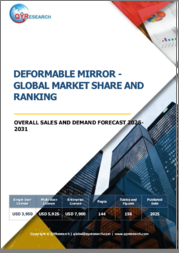
|
시장보고서
상품코드
1734797
세계의 분산 미러 시장 예측(-2032년) : 제품, 재료, 판매 채널, 제조 공정, 최종 사용자, 지역별 분석Dispersive Mirror Market Forecasts to 2032 - Global Analysis By Product (Flat Mirrors, Concave Mirrors, Convex Mirrors and Other Products), Material, Sales Channel, Manufacturing Process, End User and By Geography |
||||||
Stratistics MRC에 따르면 세계의 분산 미러 시장은 2025년에 27억 달러, 2032년에는 57억 달러에 이를 것으로 예측되며, 예측 기간 동안 CAGR은 10.9%를 나타낼 전망입니다.
분광학, 레이저 시스템 및 빛의 스펙트럼 특성을 정밀하게 제어해야 하는 기타 용도에 사용되는 광학 부품인 분산 미러는 파장에 따라 빛을 반사 및 분산하도록 만들어집니다. 모든 파장을 동일하게 반사하는 일반 미러과 달리 분산 미러는 반사 시 빛을 구성 색상 또는 파장으로 분리합니다. 일반적으로 미러에는 특수 코팅된 표면이나 구조가 있어 파장에 따라 다양한 광 경로 길이를 유도하여 높은 반사율로 빛을 분산시키고 왜곡을 최소화할 수 있습니다.
고급 광학에 대한 수요 증가
레이저 기반 약물 투여 시스템과 같은 첨단 광학 기술을 사용하여 치료 대상을 보다 정확하게 타겟팅함으로써 약물 효능을 높일 수 있습니다. 광학 기술은 흡수를 극대화하고 부작용을 최소화할 수 있기 때문에 소비자들은 더 나은 전달 메커니즘을 갖춘 일반의약품을 찾고 있습니다. 기업들은 미적으로 보기 좋은 포장과 더 간편한 약물 투여 기술에 대한 소비자의 요구에 부응하기 위해 광학 기반 솔루션에 투자하고 있습니다. 약물 관리 및 모니터링에 광학 기술을 사용하는 디지털 건강 플랫폼의 성장은 이러한 추세에 더욱 힘을 실어주고 있습니다.
숙련된 노동력의 제한적 가용성
정교한 분산 미러의 필요성은 매우 전문화된 광학 지식을 필요로 하지만, 이는 희소합니다. 따라서 제조업체는 소비자의 요구를 충족시키기 어렵고, 이로 인해 신제품의 제작과 납품이 지연됩니다. 노동력 부족은 숙련된 작업자와 엔지니어가 필요한 정밀한 설계, 제조 및 검사 절차를 방해하는 경우가 많습니다. 광학 산업의 혁신과 신기술 적응 능력도 이러한 유능한 노동력 부족의 영향을 받습니다. 그 결과 분산 미러 시장의 전반적인 성장과 경쟁력이 제약을 받고 있습니다.
보다 효율적인 코팅 개발
활성 성분의 효능은 열화를 방지하는 최첨단 코팅 덕분에 제품 유통기한 내내 유지됩니다. 개선된 코팅은 약물 방출을 제어하여 체내 흡수율을 높일 수 있습니다. 이러한 혁신은 일반의약품에 대한 소비자의 신뢰를 높여 일반의약품에 대한 시장 수요를 증가시킵니다. 또한 코팅이 개선되면 삼키기 쉬워져 의약품의 매력도가 높아집니다. 모든 것을 고려할 때, 이러한 발전은 접근 가능한 일반의약품의 선택의 폭을 넓혀 시장 확대를 촉진합니다.
원자재 가격의 변동
금속 및 코팅과 같은 필수 원자재 가격이 상승함에 따라 제조업체의 수익 마진이 압박을 받고 있습니다. 이러한 변동성 때문에 새로운 이니셔티브나 확장 시도에 대한 투자가 위축되고 있습니다. 특히 소규모 생산업체는 비용 상승을 흡수하기 어렵기 때문에 시장 경쟁이 위축될 수 있습니다. 분산 미러는 소비자들에게 더 비싼 가격이 될 수 있으며, 이는 수요를 감소시킬 수 있습니다. 결국 이러한 가격 변동은 불안정성을 초래하고 시장의 장기적인 확장과 발전을 저해합니다.
COVID-19의 영향
COVID-19의 큰 유행은 분산 미러 시장을 크게 혼란에 빠뜨렸습니다. 제조 지연, 노동력 부족, 공급망 중단으로 인해 리드 타임이 늘어나고 광학 부품이 일시적으로 부족해졌습니다. 통신, 자동차, 제조와 같은 산업은 봉쇄와 프로젝트 지연으로 인해 수요가 감소했습니다. 그러나 의료 부문에서는 첨단 이미징 및 진단 장비에 대한 투자가 증가하면서 분산 미러에 대한 수요가 증가했습니다. 산업계가 운영을 재개하고 디지털 전환이 가속화되면서 시장은 회복세를 보이기 시작했고, 연구 개발에 대한 새로운 관심이 성장을 견인했습니다.
평면 미러 부문은 예측 기간 동안 가장 클 전망
평면 미러 부문은 제품 사용 및 적용에 대한 소비자 경험을 향상시킴으로써 예측 기간 동안 가장 큰 시장 점유율을 차지할 것으로 예상됩니다. 이러한 미러는 특히 정확한 적용이나 복용량이 필요한 제품의 경우 일반 의약품 포장에 통합되는 경우가 많습니다. 사용자 편의성을 개선함으로써 소비자가 지침을 더 잘 준수하도록 장려합니다. 또한 평면 미러는 제품의 가시성과 매력을 높여 구매 결정에 영향을 줄 수 있습니다. 이러한 편의성은 향상된 포장과 함께 일반의약품의 판매를 촉진하고 시장을 확대하는 데 도움이 됩니다.
통신 부문은 예측 기간 동안 가장 높은 CAGR을 보일 전망
예측 기간 동안 통신 부문은 제조업체, 유통 업체 및 소비자 간의 효율적인 커뮤니케이션으로 인해 가장 높은 성장률을 보일 것으로 예상됩니다. 전자상거래의 출현으로 통신은 일반 의약품의 온라인 판매 플랫폼의 성장을 촉진하여 전 세계 고객이 쉽게 접근할 수 있게 되었습니다. 통신 기술을 기반으로 한 디지털 마케팅 전략은 일반의약품에 대한 인지도를 높이고 소비자 교육을 강화하는 데 도움이 됩니다. 또한 통신은 원격 의료 서비스의 통합을 지원하여 소비자가 원격으로 일반 의약품에 대한 의학적 조언과 추천을 받을 수 있도록 합니다. 또한 통신 네트워크의 발전은 더 빠르고 안정적인 배송 서비스를 보장하여 소비자 경험을 개선하고 시장 성장을 촉진합니다.
최대 점유율을 차지하는 지역 :
예측 기간 동안 아시아태평양 지역은 전자, 자동차 및 연구 부문의 호황으로 인해 가장 큰 시장 점유율을 차지할 것으로 예상됩니다. 라이더, 광학 센서, 레이저 기반 시스템과 같은 첨단 기술의 채택이 증가함에 따라 효율적인 분산 미러에 대한 수요가 증가하고 있습니다. 중국, 일본, 인도와 같은 국가들이 연구 개발 활동에 대한 투자를 늘리면서 주요 기여를 하고 있습니다. 이 시장은 과학 연구의 증가와 강력한 제조 기반 덕분에 비용 효율적인 생산이 가능하고 글로벌 수요를 충족할 수 있어 글로벌 시장의 핵심 플레이어로 부상하고 있습니다.
CAGR이 가장 높은 지역 :
예측 기간 동안 북미 지역은 광학 및 포토닉스 기술의 상당한 발전으로 인해 가장 높은 CAGR을 보일 것으로 예상됩니다. 통신, 항공우주, 헬스케어와 같은 산업에서 고성능 광학 시스템에 대한 수요가 증가하면서 성장을 촉진하고 있습니다. 북미 제조업체들은 분광학, 레이저 시스템 및 이미징 분야의 애플리케이션을 위해 빛의 분산을 향상시키는 정밀 미러 개발에 주력하고 있습니다. 연구 개발에 대한 정부의 투자는 시장의 확장을 더욱 뒷받침하고 있습니다. 또한 주요 기업과 대학 간의 협력은 혁신을 강화하여 이 지역 시장에 유망한 기회를 제공합니다.
무료 맞춤화 서비스
이 보고서를 구독하는 고객은 다음 무료 맞춤화 옵션 중 하나를 사용할 수 있습니다.
- 기업 프로파일
- 추가 시장 기업의 종합적 프로파일링(최대 3개사)
- 주요 기업의 SWOT 분석(최대 3개사)
- 지역 세분화
- 고객의 관심에 응한 주요국 시장 추계, 예측 및 CAGR(참고 : 타당성 확인에 따라 다름)
- 경쟁 벤치마킹
- 제품 포트폴리오, 지리적 존재, 전략적 제휴에 기반한 주요 기업 벤치마킹
목차
제1장 주요 요약
제2장 서문
- 개요
- 이해관계자
- 조사 범위
- 조사 방법
- 데이터 마이닝
- 데이터 분석
- 데이터 검증
- 조사 접근
- 조사 자료
- 1차 조사 자료
- 2차 조사 자료
- 전제조건
제3장 시장 동향 분석
- 성장 촉진요인
- 억제요인
- 기회
- 위협
- 제품분석
- 최종 사용자 분석
- 신흥 시장
- COVID-19의 영향
제4장 Porter's Five Forces 분석
- 공급기업의 협상력
- 구매자의 협상력
- 대체품의 위협
- 신규 참가업체의 위협
- 경쟁 기업간 경쟁 관계
제5장 세계의 분산 미러 시장 : 제품별
- 평면 미러
- 오목 미러
- 볼록 미러
- 기타 제품
제6장 세계의 분산 미러 시장 : 재료별
- 유리 미러
- 금속 미러
- 코팅 미러
- 기타 재료
제7장 세계의 분산 미러 시장 : 판매 채널별
- OEM
- 애프터마켓 판매
- 직접 판매
- 리셀러
제8장 세계의 분산 미러 시장 : 제조 공정별
- 연마
- 다이아몬드 선삭
- 성형 및 주조
- 에칭과 리소그래피
- 레이저 가공
- 기타 제조 공정
제9장 세계의 분산 미러 시장 : 최종 사용자별
- 광학 및 포토닉스
- 통신
- 항공우주 및 방위
- 의료 및 헬스케어
- 자동차 및 운송
- 가전
- 연구 및 교육기관
- 기타 최종 사용자
제10장 세계의 분산 미러 시장 : 지역별
- 북미
- 미국
- 캐나다
- 멕시코
- 유럽
- 독일
- 영국
- 이탈리아
- 프랑스
- 스페인
- 기타 유럽
- 아시아태평양
- 일본
- 중국
- 인도
- 호주
- 뉴질랜드
- 한국
- 기타 아시아태평양
- 남미
- 아르헨티나
- 브라질
- 칠레
- 기타 남미
- 중동 및 아프리카
- 사우디아라비아
- 아랍에미리트(UAE)
- 카타르
- 남아프리카
- 기타 중동 및 아프리카
제11장 주요 발전
- 계약, 파트너십, 협업, 합작투자
- 인수와 합병
- 신제품 발매
- 사업 확대
- 기타 주요 전략
제12장 기업 프로파일링
- Thorlabs Inc.
- Newport Corporation
- Edmund Optics Inc.
- Laseroptik GmbH
- Layertec GmbH
- CVI Laser Optics
- OptoSigma Corporation
- Gooch & Housego PLC
- Semrock Inc.
- Del Mar Photonics Inc.
- Spectra-Physics
- UltraFast Innovations
- Tokyo Instruments
- R&D Ultrafast Lasers
- Altechna
- Cycle
- EKSMA Optics
- Research Electro-Optics Inc.
According to Stratistics MRC, the Global Dispersive Mirror Market is accounted for $2.7 billion in 2025 and is expected to reach $5.7 billion by 2032 growing at a CAGR of 10.9% during the forecast period. Dispersive mirrors, which are optical components that are used in spectroscopy, laser systems, and other applications that require precise control of light's spectral properties, are made to both reflect and disperse light according to wavelength. Unlike conventional mirrors, which reflect all wavelengths equally, dispersive mirrors separate light into its constituent colours or wavelengths upon reflection. Typically, the mirror has a specially coated surface or structure that induces varying optical path lengths for different wavelengths, allowing for the dispersion of light from high reflectivity and minimal distortion.
Market Dynamics:
Driver:
Increasing demand for advanced optics
Drug efficacy can be increased by more precisely targeting treatments using advanced optical technology, such as laser-based drug administration systems. Because optics can maximise absorption and minimise adverse effects, consumers are also looking for over-the-counter medications with better delivery mechanisms. Businesses have invested in optics-driven solutions in response to consumer demand for aesthetically pleasing packaging and simpler medicine administration techniques. The growth of digital health platforms, which employ optical technology for drug management and monitoring, lends additional credence to this trend.
Restraint:
Limited availability of skilled labour
The need for sophisticated dispersive mirrors necessitates extremely specialised optical knowledge, which is scarce. Manufacturers thus find it difficult to satisfy consumer demands, which causes delays in the creation and delivery of new products. Labour shortages frequently impede precise design, manufacture, and testing procedures, which require skilled workers and engineers. Innovation and the capacity to adjust to new technologies in the optical industry are also impacted by this shortage of competent labour. As a result, the dispersive mirror market's overall growth and competitiveness are constrained.
Opportunity:
Development of more efficient coatings
The efficacy of the active components is maintained throughout the product's shelf life thanks to these cutting-edge coatings, which shield them from deterioration. Improved coatings allow for greater absorption in the body by controlling medication release. This innovation boosts the market demand for over-the-counter medications by increasing consumer faith in them. Better coatings can also make swallowing easier, which increases the attraction of pharmaceuticals. All things considered, these developments broaden the selection of over-the-counter products that are accessible, driving market expansion.
Threat:
Fluctuations in raw material prices
Profit margins for manufacturers are being strained as the cost of essential commodities like metals and coatings increases. Investment in new initiatives or expansion attempts is discouraged by this volatility. Cost rises are particularly difficult for smaller producers to absorb, which may lessen market competition. Dispersive mirrors may become more expensive for consumers, which would decrease demand. In the end, these price swings lead to instability and impede the long-term expansion and advancement of the market.
Covid-19 Impact
The COVID-19 pandemic significantly disrupted the dispersive mirror market. Manufacturing delays, labour shortages, and supply chain interruptions led to increased lead times and temporary shortages of optical components. Industries like telecommunications, automotive, and manufacturing experienced reduced demand due to lockdowns and project delays. However, the healthcare sector saw increased investments in advanced imaging and diagnostic equipment, boosting demand for dispersive mirrors. As industries resumed operations and digital transformation accelerated, the market began recovering, with renewed focus on research and development driving growth.
The flat mirrors segment is expected to be the largest during the forecast period
The flat mirrors segment is expected to account for the largest market share during the forecast period by enhancing the consumer experience in product usage and application. These mirrors are often incorporated in OTC drug packaging, especially for products requiring precise application or dosage. By improving user-friendliness, they encourage better consumer adherence to instructions. Additionally, flat mirrors aid in boosting product visibility and appeal, which can influence purchase decisions. This convenience, along with enhanced packaging, helps drive sales and expand the market for OTC drugs.
The telecommunications segment is expected to have the highest CAGR during the forecast period
Over the forecast period, the telecommunications segment is predicted to witness the highest growth rate due to efficient communication between manufacturers, distributors, and consumers. With the advent of e-commerce, telecommunications have facilitated the growth of online sales platforms for OTC drugs, making them easily accessible to a global audience. Digital marketing strategies powered by telecommunication technologies help increase awareness and educate consumers about OTC drug options. Telecommunications also support the integration of telehealth services, allowing consumers to access medical advice and recommendations for OTC products remotely. Moreover, advancements in telecommunication networks ensure faster and more reliable delivery services, improving consumer experience and driving market growth.
Region with largest share:
During the forecast period, the Asia Pacific region is expected to hold the largest market share due to the region's booming electronics, automotive, and research sectors. The growing adoption of advanced technologies such as lidar, optical sensors, and laser-based systems is driving demand for efficient dispersive mirrors. Countries like China, Japan, and India are major contributors, with increasing investments in research and development activities. The market benefits from the rise in scientific research and a strong manufacturing base, enabling cost-effective production and catering to global demand, making the region a key player in the global market.
Region with highest CAGR:
Over the forecast period, the North America region is anticipated to exhibit the highest CAGR by significant advancements in optics and photonics technologies. The increasing demand for high-performance optical systems in industries such as telecommunications, aerospace, and healthcare is fuelling growth. North American manufacturers focus on developing precision mirrors that enhance light dispersion for applications in spectroscopy, laser systems, and imaging. Government investments in research and development further support the market's expansion. Additionally, collaborations between key players and universities enhance innovation, offering promising opportunities for the market in the region.
Key players in the market
Some of the key players profiled in the Dispersive Mirror Market include Thorlabs Inc., Newport Corporation, Edmund Optics Inc., Laseroptik GmbH, Layertec GmbH, CVI Laser Optics, OptoSigma Corporation, Gooch & Housego PLC, Semrock Inc. (IDEX Health & Science), Del Mar Photonics Inc., Spectra-Physics, UltraFast Innovations, Tokyo Instruments, R&D Ultrafast Lasers, Altechna, Cycle, EKSMA Optics and Research Electro-Optics Inc.
Key Developments:
In January 2025, Thorlabs acquired Praevium Research, a leader in developing high-speed tunable Vertical Cavity Surface Emitting Lasers (VCSELs). This acquisition enhances Thorlabs' capabilities in ultrafast optics, aligning with the demands of the dispersive mirror market.
In October 2024, Thorlabs partnered with Infleqtion to advance quantum technology applications. This collaboration focuses on integrating optical components, which are crucial for high-precision mirrors used in quantum systems.
Products Covered:
- Flat Mirrors
- Concave Mirrors
- Convex Mirrors
- Other Products
Materials Covered:
- Glass Mirrors
- Metal Mirrors
- Coated Mirrors
- Other Materials
Sales Channels Covered:
- Original Equipment Manufacturers
- Aftermarket Sales
- Direct Sales
- Distributors
Manufacturing Processes Covered:
- Polishing
- Diamond Turning
- Molding & Casting
- Etching & Lithography
- Laser Processing
- Other Manufacturing Processes
End Users Covered:
- Optics and Photonics
- Telecommunications
- Aerospace & Defense
- Medical & Healthcare
- Automotive & Transportation
- Consumer Electronics
- Research & Educational Institutions
- Other End Users
Regions Covered:
- North America
- US
- Canada
- Mexico
- Europe
- Germany
- UK
- Italy
- France
- Spain
- Rest of Europe
- Asia Pacific
- Japan
- China
- India
- Australia
- New Zealand
- South Korea
- Rest of Asia Pacific
- South America
- Argentina
- Brazil
- Chile
- Rest of South America
- Middle East & Africa
- Saudi Arabia
- UAE
- Qatar
- South Africa
- Rest of Middle East & Africa
What our report offers:
- Market share assessments for the regional and country-level segments
- Strategic recommendations for the new entrants
- Covers Market data for the years 2024, 2025, 2026, 2028, and 2032
- Market Trends (Drivers, Constraints, Opportunities, Threats, Challenges, Investment Opportunities, and recommendations)
- Strategic recommendations in key business segments based on the market estimations
- Competitive landscaping mapping the key common trends
- Company profiling with detailed strategies, financials, and recent developments
- Supply chain trends mapping the latest technological advancements
Free Customization Offerings:
All the customers of this report will be entitled to receive one of the following free customization options:
- Company Profiling
- Comprehensive profiling of additional market players (up to 3)
- SWOT Analysis of key players (up to 3)
- Regional Segmentation
- Market estimations, Forecasts and CAGR of any prominent country as per the client's interest (Note: Depends on feasibility check)
- Competitive Benchmarking
- Benchmarking of key players based on product portfolio, geographical presence, and strategic alliances
Table of Contents
1 Executive Summary
2 Preface
- 2.1 Abstract
- 2.2 Stake Holders
- 2.3 Research Scope
- 2.4 Research Methodology
- 2.4.1 Data Mining
- 2.4.2 Data Analysis
- 2.4.3 Data Validation
- 2.4.4 Research Approach
- 2.5 Research Sources
- 2.5.1 Primary Research Sources
- 2.5.2 Secondary Research Sources
- 2.5.3 Assumptions
3 Market Trend Analysis
- 3.1 Introduction
- 3.2 Drivers
- 3.3 Restraints
- 3.4 Opportunities
- 3.5 Threats
- 3.6 Product Analysis
- 3.7 End User Analysis
- 3.8 Emerging Markets
- 3.9 Impact of Covid-19
4 Porters Five Force Analysis
- 4.1 Bargaining power of suppliers
- 4.2 Bargaining power of buyers
- 4.3 Threat of substitutes
- 4.4 Threat of new entrants
- 4.5 Competitive rivalry
5 Global Dispersive Mirror Market, By Product
- 5.1 Introduction
- 5.2 Flat Mirrors
- 5.3 Concave Mirrors
- 5.4 Convex Mirrors
- 5.5 Other Products
6 Global Dispersive Mirror Market, By Material
- 6.1 Introduction
- 6.2 Glass Mirrors
- 6.3 Metal Mirrors
- 6.4 Coated Mirrors
- 6.5 Other Materials
7 Global Dispersive Mirror Market, By Sales Channel
- 7.1 Introduction
- 7.2 Original Equipment Manufacturers
- 7.3 Aftermarket Sales
- 7.4 Direct Sales
- 7.5 Distributors
8 Global Dispersive Mirror Market, By Manufacturing Process
- 8.1 Introduction
- 8.2 Polishing
- 8.3 Diamond Turning
- 8.4 Molding & Casting
- 8.5 Etching & Lithography
- 8.6 Laser Processing
- 8.7 Other Manufacturing Processes
9 Global Dispersive Mirror Market, By End User
- 9.1 Introduction
- 9.2 Optics and Photonics
- 9.3 Telecommunications
- 9.4 Aerospace & Defense
- 9.5 Medical & Healthcare
- 9.6 Automotive & Transportation
- 9.7 Consumer Electronics
- 9.8 Research & Educational Institutions
- 9.9 Other End Users
10 Global Dispersive Mirror Market, By Geography
- 10.1 Introduction
- 10.2 North America
- 10.2.1 US
- 10.2.2 Canada
- 10.2.3 Mexico
- 10.3 Europe
- 10.3.1 Germany
- 10.3.2 UK
- 10.3.3 Italy
- 10.3.4 France
- 10.3.5 Spain
- 10.3.6 Rest of Europe
- 10.4 Asia Pacific
- 10.4.1 Japan
- 10.4.2 China
- 10.4.3 India
- 10.4.4 Australia
- 10.4.5 New Zealand
- 10.4.6 South Korea
- 10.4.7 Rest of Asia Pacific
- 10.5 South America
- 10.5.1 Argentina
- 10.5.2 Brazil
- 10.5.3 Chile
- 10.5.4 Rest of South America
- 10.6 Middle East & Africa
- 10.6.1 Saudi Arabia
- 10.6.2 UAE
- 10.6.3 Qatar
- 10.6.4 South Africa
- 10.6.5 Rest of Middle East & Africa
11 Key Developments
- 11.1 Agreements, Partnerships, Collaborations and Joint Ventures
- 11.2 Acquisitions & Mergers
- 11.3 New Product Launch
- 11.4 Expansions
- 11.5 Other Key Strategies
12 Company Profiling
- 12.1 Thorlabs Inc.
- 12.2 Newport Corporation
- 12.3 Edmund Optics Inc.
- 12.4 Laseroptik GmbH
- 12.5 Layertec GmbH
- 12.6 CVI Laser Optics
- 12.7 OptoSigma Corporation
- 12.8 Gooch & Housego PLC
- 12.9 Semrock Inc.
- 12.10 Del Mar Photonics Inc.
- 12.11 Spectra-Physics
- 12.12 UltraFast Innovations
- 12.13 Tokyo Instruments
- 12.14 R&D Ultrafast Lasers
- 12.15 Altechna
- 12.16 Cycle
- 12.17 EKSMA Optics
- 12.18 Research Electro-Optics Inc.



















